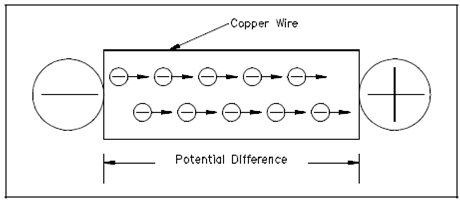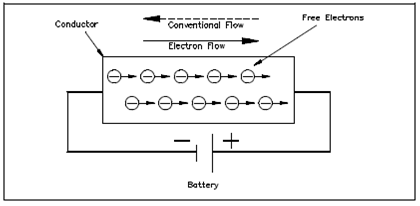Current:
The density of the atoms in copper wire is such in which the valence orbits of the individual atoms overlap, causing the electrons to move simply from one atom to the next. Free electrons could drift from one orbit to another in a random direction. Whenever a potential difference is applied, the direction of their movement is controlled. Strength of the potential difference applied at each end of the wire determines how many electrons modify from a random motion to a more directional path by the wire. A movement or flow of these electrons is known as electron current flow or only current.
To generate current, the electrons have to be moved through a potential difference. A symbol for current is (I). A basic measurement for current is the ampere (A). A single ampere of current is declared as the movement of one coulomb of charge past any given point of a conductor in during one second of time.
If a copper wire is placed among two charged objects which have a potential difference, all of the negatively-charged free electrons will feel a force pushing them from the negative charge to the positive charge. This force opposite to the conventional direction of the electrostatic lines of force is displays in Figure.

Figure: Electron Flow through a Copper Wire with a Potential Difference
The direction of electron flow, displays in Figure, is from the negative (-) side of the battery, by the wire, and back to the positive (+) side of the battery. A direction of electron flow is from a point of negative potential to a point of positive potential. The solid arrow display in Figure denotes the direction of electron flow. As electrons vacate their atoms in during electron current flow, positively charged atoms (holes) result. A flow of electrons in one direction causes a flow of positive charges.
A direction of the positive charges is in the opposite direction of the electron flow. That flow of positive charges is known as conventional current and is shown in Figure 10 as a dashed arrow. Whole of the electrical effects of electron flow from negative to positive or from a higher potential to a lower potential, are the similar as those which would be created by a flow of positive charges in the opposite direction. Thus, it is significant to realize that both conventions are in use and that they are essentially equivalent; that is, all effects predicted are the same. In this text, we will be using electron flow in our discussions.

Figure: Potential Difference across a Conductor Causes a Current to Flow
Commonly, electric current flow could be classified as one of two common types: DC (Direct Current) or AC (Alternating Current). A direct current flows continuously in the similar direction. An alternating current periodically reverses direction. We will be studying AC and DC current in more detail later in this text. An instance of DC current is in which current obtained from a battery. An instance of AC current is general household current.